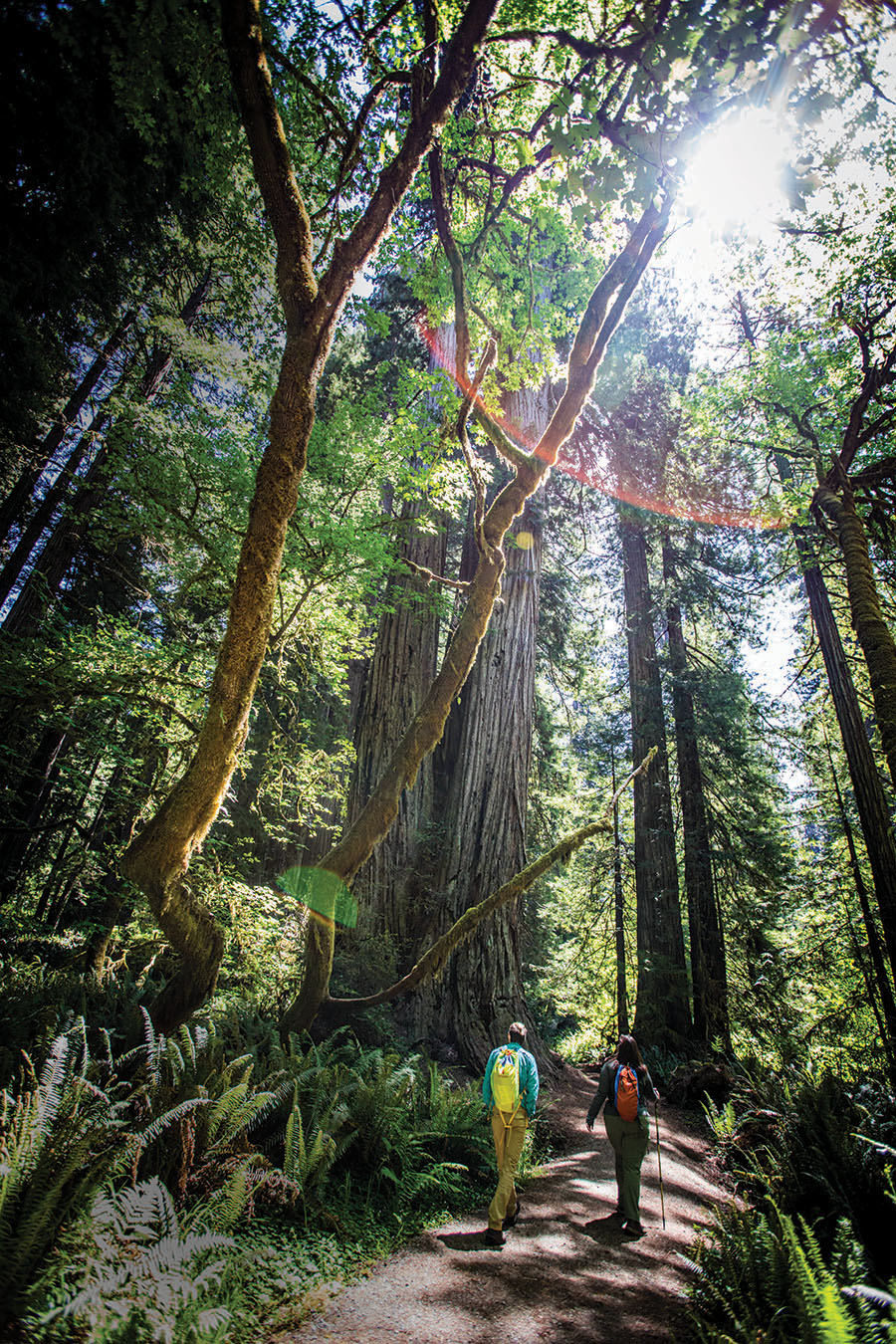
“I have seen some of the most amazing things that I couldn’t even imagine,” Brett Lang said of the experiences he and his wife, Marcy, share as park rangers with the National Park Service.
Hiking Redwood National and State Parks and the trails of southwest Oregon with Brett ’18 and Marcy McKay ’16 Lang is like participating in a master class about the geological and biological components that make up the complex ecosystem and breathtaking features of those landscapes.
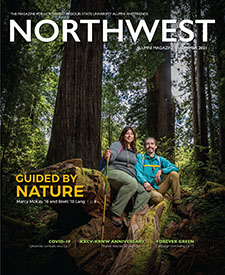
This story appears in the 2021 summer edition of the Northwest Alumni Magazine.
For additional photos, visit this photo gallery.
After all, the Langs have to know their stuff as park rangers with the National Park Service. But it’s much more than a job to them.
Their passion for the subject material – from the banana slugs living among the majestic redwood trees to the green-tinted serpentine scattered across rock formations – becomes more evident with every step.
Coming from rural homes in the Midwest, the Langs say their journey sometimes feels like a dream.
“I have seen some of the most amazing things that I couldn’t even imagine,” Brett said while hiking with Marcy through Prairie Creek Redwoods State Park on one of their off days in mid-May. “It’s like being transported to a different world – and it’s not just going there. It’s being entrusted through my education and through my experience that I can go out and make sure everyone gets to experience these beautiful places.”
The Langs are a contrast in personalities bound by a shared passion for the natural environment. Marcy grew up in rural Tekamah, Nebraska, a town of about 1,700 people near Nebraska’s eastern border, 45 miles north of Omaha. Brett hails from the larger Sedalia, Missouri, in the center of the state and home to the Missouri State Fair.
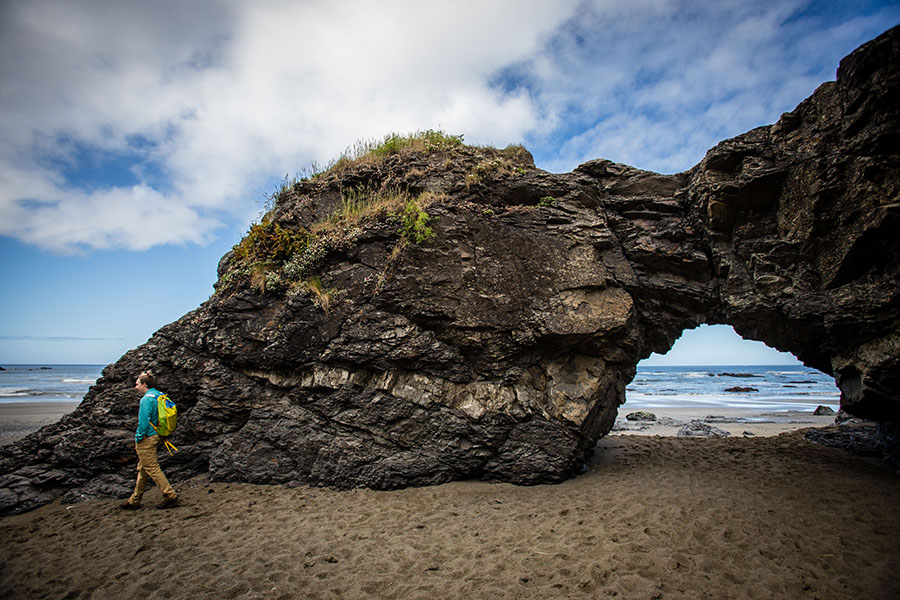
Brett Lang hikes a beach near Crescent City, California, during an off day in mid-May.
Marcy, a self-described “super go-getter,” was valedictorian of her high school graduating class. She participated in academic decathlons and quiz bowls and enjoyed the challenge of her biology classes. While her family didn’t travel much, she thought maybe she’d try to become a veterinarian.
Brett, on the other hand, was the kid who accompanied his family to his older brother’s ball games but found more enjoyment in wandering from the bleachers to throw stones in nearby creeks and explore the natural surroundings. “It felt like a completely different world, and that kept me distracted enough to sit through hundreds of baseball games,” he said.
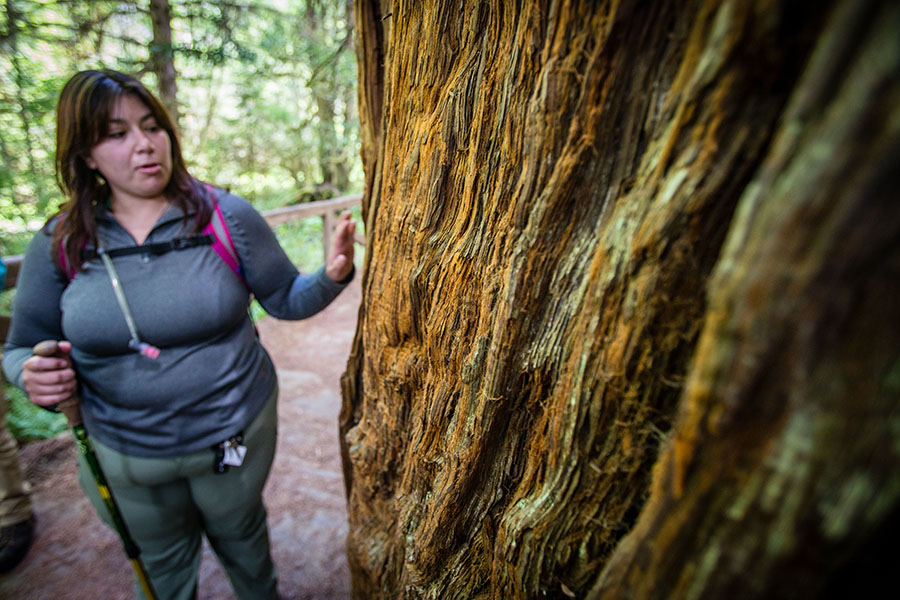
Marcy Lang notes the features of a redwood tree at Prairie Creek Redwoods State Park, which features the region’s iconic trees and where the Langs spent a summer season educating visitors about the forest’s unique ecosystem.
Yet, their connection at Northwest was practically instantaneous. As incoming freshmen with shared interests in biology-related majors, they were placed in the same group during Summer Orientation Advisement and Registration, more commonly known as SOAR. They caught each other’s eyes over a couple rows of seats in the Mary Linn Auditorium and later exchanged contact information in the hallway. They began dating about a month later and were nearly inseparable as undergraduate students.
“She said she saw me and she knew that there was something special about me,” Brett recalled. “Whenever I saw her, being the awkward freshman that I was, I would throw out the cool facts about myself, like I had a pet tarantula and try to impress her – and somehow it worked.”
At Northwest, they took advantage of the experiences that clubs and field trips provided, in addition to exploring the region’s natural offerings on their own. They enjoyed regular hikes along the 102 River, sometimes wading through the water for hours to collect unique rocks and fossils. Their travels with University-sanctioned field trips took them to Arkansas for camping and canoeing on the Buffalo National River, to Michigan for a tour of an underground mine and multiple national parks.
“That was the thing that got me about geology was no other major went out for two weeks in a van and just toured the United States and checked out the geology,” Marcy said. “That was really my favorite thing.”
As she completed her bachelor’s degree in environmental geology, Marcy got a foot in the door of the National Park Service’s competitive job field through its Geoscientists in the Parks program, an immersive internship experience for young adults who aspire to work in national parks. She landed a spot at Oregon Caves National Monument and Preserve in Cave Junction, Oregon, interning for three months during the summer of 2016 and then was hired for an additional month.
Having never been to California or Oregon, let alone taking a road trip on her own, the first thing she did was drive to Pebble Beach in northern California to see the Pacific Ocean.
“A lot of people in my life told me, ‘Are you sure you want to do this by yourself?’” she said, adding that she wasn’t yet 21 years old but persisted with Brett’s strong support. “It’s a really special place. I don’t know a lot of other places where you can be up in the mountains, like an hour away and then come straight to the ocean.”
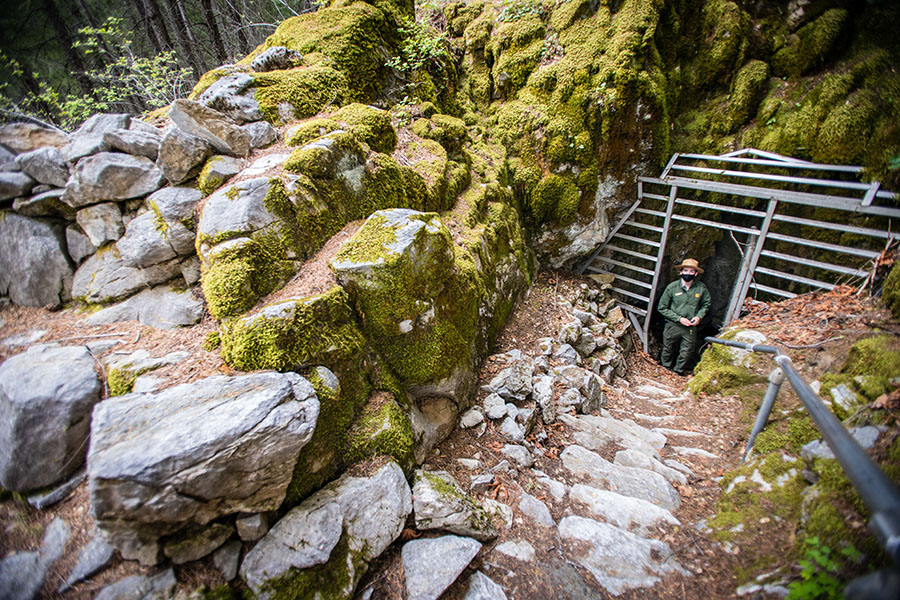
As a park ranger at Oregon Caves National Monument and Preserve, Brett Lang leads daily tours inside the marble caves and takes pride in telling the stories of its formations.
That summer, Brett, on his way to completing a bachelor’s degree in wildlife ecology and conservation at Northwest, got his first taste of the West Coast while visiting Marcy and was convinced he wanted a career with the National Park Service, too. After marrying in Hawaii, both Brett and Marcy worked at Oregon Caves as park rangers for the 2017 and 2018 summer seasons. Marcy’s experience also allowed her to advance to a tour coordinator role and manage teams of park rangers at Oregon Caves.
In 2019, the Langs were hired to work at Redwood National and State Parks, engaging with about 2,000 visitors a day in the southern district of the iconic 139,000-acre park that cuts across the northern half of the California coast. The Langs staffed the beachside Thomas H. Kuchel Visitor Center, led guided hikes, campfire programs and roved the park to interact with visitors on trails.
While a percentage of park rangers work in law enforcement, the Langs specialize in interpretation. They credit Northwest for providing them with foundational knowledge in wildlife ecology, conservation and geology, but the people skills are learned on the job.
“You can keep learning and keep adding to your knowledge and your specialty, but really being a park ranger is being able to evaluate your crowd, evaluate who you’re talking to and take a really complex subject and pare it down enough for people to have something to take away from it,” Marcy said.
The couple teases that Marcy takes on a more polished, academic persona, while Brett is an unabashed storyteller. One weekend when the Langs were leading campfire programs during their season at Redwood, Brett presented “Taking a Gander at a Salamander,” and Marcy discussed “North Coast Beach Patterns: Tsunamis and Other Concerns.”
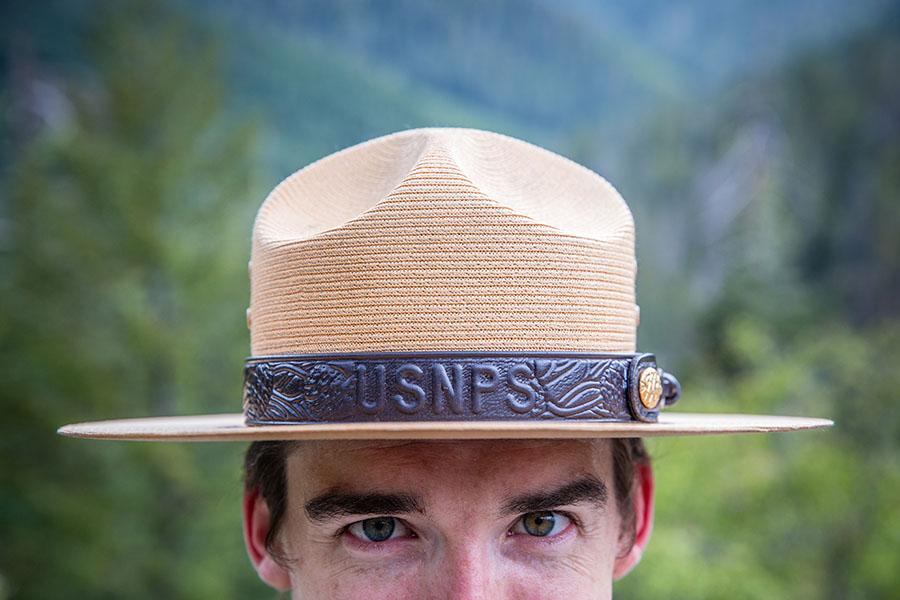
The Langs take pride in representing the National Park Service and educating visitors about the history and features of the parks.
“Brett is like the quintessential park ranger,” Marcy said. “He has a good voice for it. People love him. I’m more professorial with a more scientific approach.”
Often, it’s the conversations with visitors along park trails that make the most impactful connections.
“Sometimes all you need to do is just make them smile and help them remember that they’re out here in this wild place and they’re getting to experience it for themselves rather than watch it on a documentary,” Brett said. “Whenever you put on the uniform and you take that persona as a park ranger, you’re the person that people will seek out for information, so you feel that bit of duty and honor in doing it.”
Everyone has a story about the ways the COVID-19 pandemic impacted their lives. For the Langs, it put an agonizing pause on their ambitions with the National Park Service.
The couple was readying to return to Oregon Caves in the spring of 2020 when the pandemic arrived in the United States. Like most people and businesses, they held to hope that the virus would run its course and their lives would return to normalcy at some point during the summer. But their start dates continued to be delayed as the National Park Service implemented its own mitigation measures.
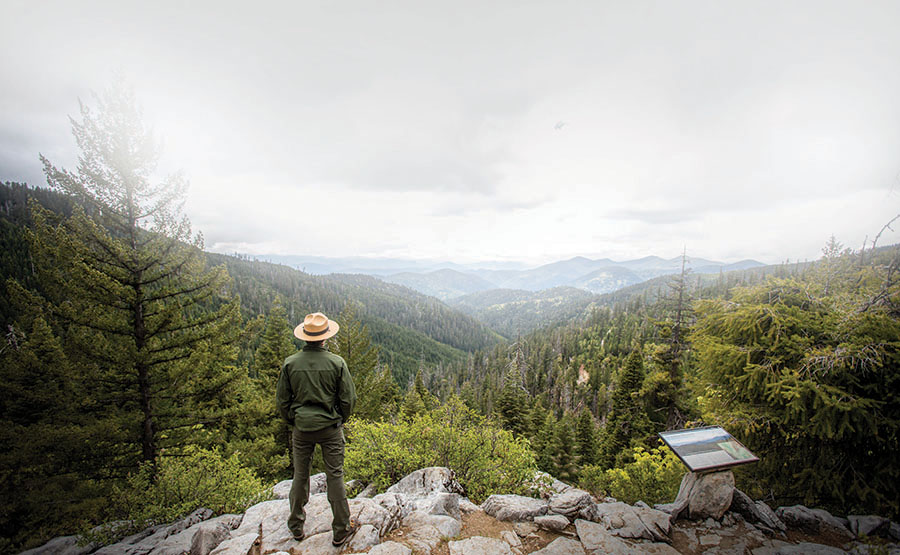
Brett Lang stands in appreciation of a view of the Siskiyou Mountains at Oregon Caves National Monument and Preserve.
The parks remained open in 2020 but operated at minimum capacity, which meant fewer park rangers were needed. Oregon Caves halted its underground tours. Park service workers shared their experiences and frustration in Facebook groups and Reddit threads. Like everything else, park policies and guidelines seemed to change at a rapid pace.
Brett was finishing the winter season at Redwood when the state of California began enforcing stay-at-home orders. With Marcy already back at their offseason home in Nebraska, he spent 37 days living alone in park service housing, leaving the park only for groceries and other necessities. When the season ended in April, he loaded his 2004 Mazda 6 and drove the 27-hour, 1,800-mile trek nearly non-stop from Orick, California, to Omaha. As the pandemic continued, he found comfort in hiking the Missouri River, fishing and practicing his photography. He worked a stint at Fontenelle Forest, south of Omaha, and then went to work at Target during the winter months.
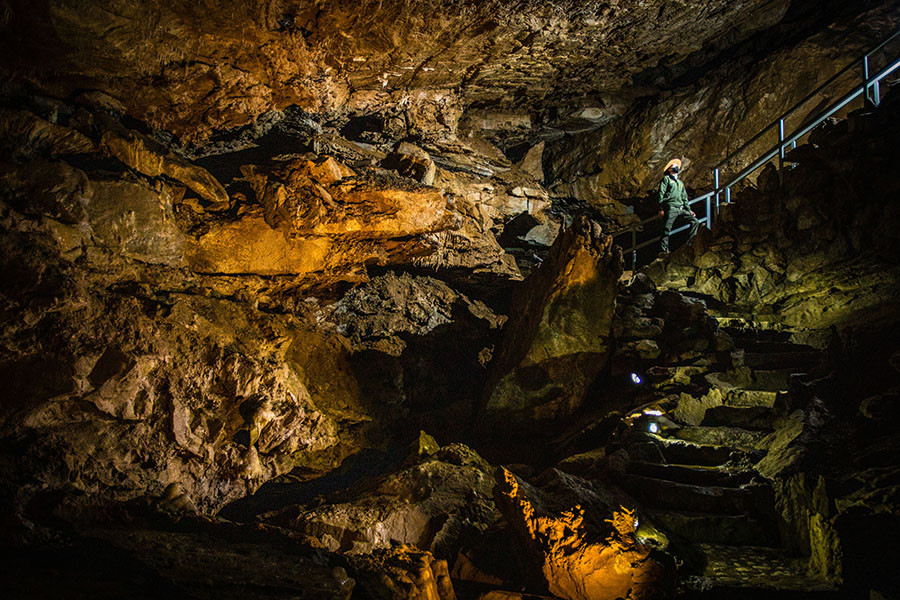
Brett Lang travels a staircase inside Oregon Caves, which features stunning formations shaped over a million years as rain seeped through the Siskiyou Mountains’ forest soil to create one of the world’s few marble caves.
Marcy had some luck securing a job with the Nebraska Game and Parks Commission and spent her offseason working as a naturalist at Schramm Education Center in Gretna. She did everything from handling snakes for education programs to caring for the aquarium fish. She also created a virtual geology program for schools, bagging fossils and dirt that she sent to students with handouts. During Zoom sessions, she led activities with the students as they sifted through the dirt to identify the fossils.
The couple, who have traveled to nearly every state in the western half of the country, filled the rest of their time during the pandemic visiting friends and exploring other parks, including Rocky Mountain National Park in Colorado and Denali National Park and Preserve in Alaska.
Their time away from northern California and southwest Oregon also gave them a renewed appreciation for the natural wonders they experience nearly every day as park rangers.
“Most people tell me it’s on their bucket list,” Marcy said as she reflected on people’s fascination with Redwood. “I think when it really hit me was actually coming back this season and we drove through it, and I finally get it. I finally get the big trees after living in Nebraska. I had been exposed to them quite a bit, living in southwestern Oregon. I've seen them before, but then I came back and I’m like, ‘You know what? This is a very special place. This is a big deal.’”
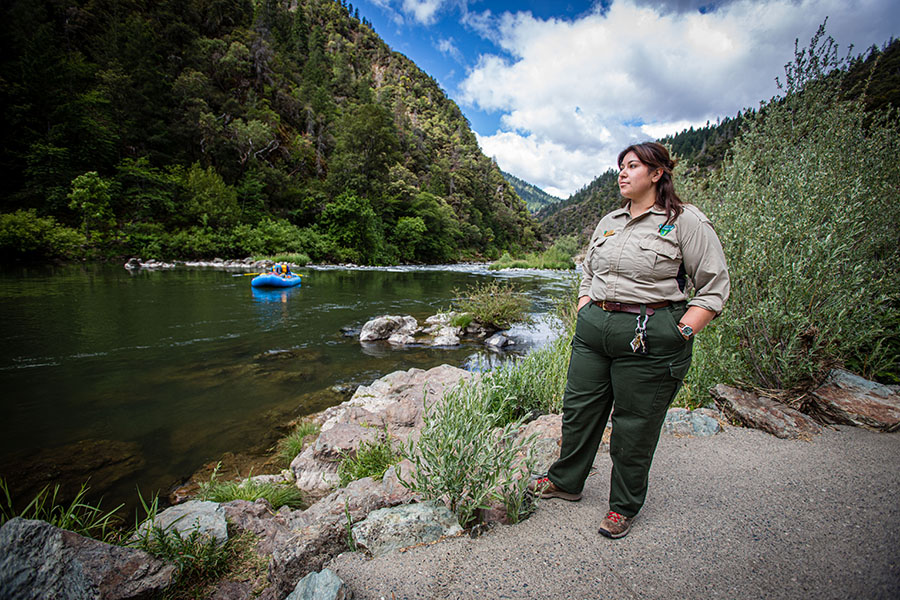
Marcy Lang is working this summer as a visitor use park ranger with the Bureau of Land Management and is stationed at Smullin Visitor Center at the Rand Recreation Area in Merlin, Oregon.
This summer, with attendance at national parks expected to break records as the nation tries to put the pandemic in its rearview mirror, the Langs are back where they want to be in southwest Oregon.
Marcy is a visitor use park ranger with the Bureau of Land Management and is stationed at Smullin Visitor Center at the Rand Recreation Area in Merlin, Oregon. It’s a required stop to obtain permits for the Rogue River National Recreation Trail, a rugged 40-mile stretch offering plentiful hiking, rafting, fishing and wildlife viewing.
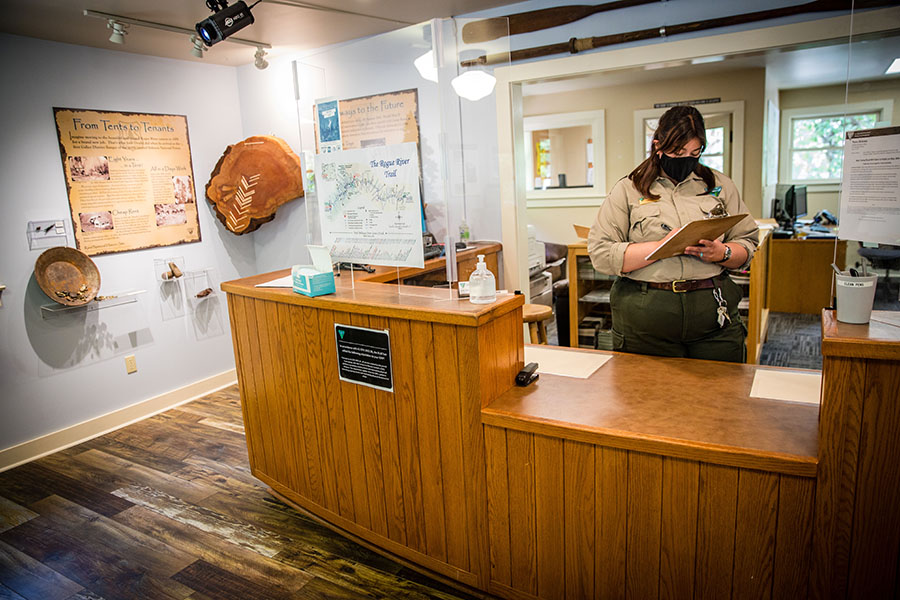
Marcy Lang issues permits and monitors rafting on the Rogue River as a visitor use park ranger with the Bureau of Land Management and the Rand Recreation Area in Merlin, Oregon.
It’s also another advancement in her career that provides experience with issuing permits and visitor engagement as well as emergency response. “It’s true wilderness,” she said. “It’s more dangerous than we think it is, and that’s part of the importance of having rangers is making sure that there is as little injury as possible and that the land is being used appropriately, that we’re leaving as little impact on it as we can.”
Brett, meanwhile, returned to Oregon Caves, where he takes an effusive pride in leading visitors into the stunning formations shaped over a million years as rain seeped through the Siskiyou Mountains’ forest soil to create one of the world’s few marble caves. With features like Miller’s Chapel, a 45-foot tall room featuring some of the cave’s largest formations, and Paradise Lost, a 120-foot high formed by an ancient waterfall, Oregon Caves is a living thing all its own.
“We will get people who come back after 30, 40 years,” Brett said. “They come back, walking through the cave they walked through with their parents to see the formations that inspired them. It’s one of those feelings that puts it perspective that isn’t just a job. It’s something that brings people to a calling. You’re inspiring other people.”
While some are content with the seasonal work, many park rangers like the Langs are trying to secure full-time, year-round employment through the provisions of the Land Management Workforce Flexibility Act. Signed into law in 2015, the act provides a pathway for individuals working time-limited appointments in land management agencies to seek permanent positions. To be eligible, employees must accrue a cumulative 24 months of service in one or more time-limited appointments in a land management agency without a break lasting two or more years.
Marcy aspires to become a supervisory park ranger and will qualify for a permanent position by the end of the current season. Brett is just behind her, and the couple hopes to soon secure full-time positions with the National Park Service or the Bureau of Land Management that allow them to live in the region year-round.
“We’ve made it work, and everyone has struggles in their life,” Marcy said. “There’s been a lot of focus in life on what you should be doing for a career, where you should be, family structure, but there’s not a lot of focus that people put on being in the right place, and I do think that’s important.”